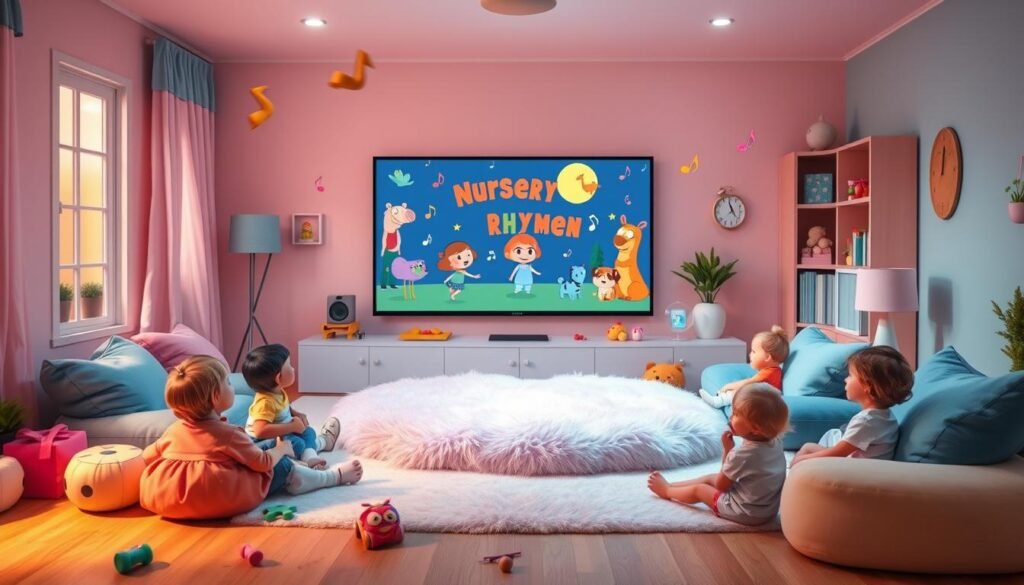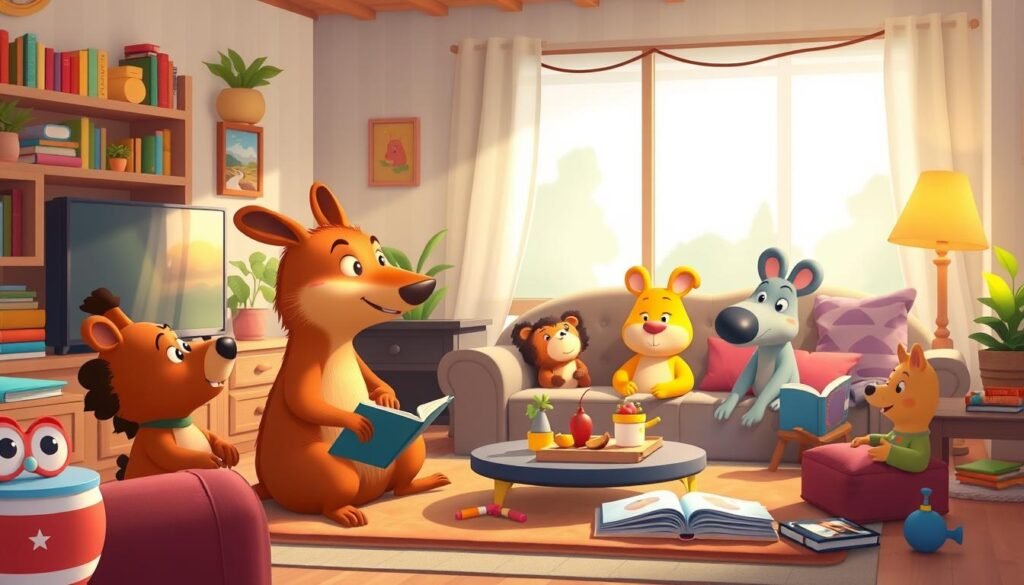The AAP suggests limiting toddlers’ non-educational screen time. They recommend about 1 hour on weekdays and 3 hours on weekends. Many kids’ shows use bright colors, loud sounds, and quick scene changes.
These elements can overstimulate young viewers. Finding the right shows can be tricky. Low-stimulation programs offer a calming alternative for toddlers.
This article explores the benefits of these shows. We’ll recommend calming, educational TV programs for a relaxed viewing experience. These options can help foster focus in young children.
Table of Contents
ToggleKey Takeaways
- Low-stimulation shows for toddlers typically feature soothing visuals, gentle music, and a slower pace to avoid overstimulation.
- These calming TV programs can help decrease hyperactivity and anxiety in young viewers.
- Many parents find it important for their toddlers to watch low-stimulation shows, and some even use them to help their children relax before bedtime.
- The article will recommend a variety of low-stimulation TV shows across different genres, including adventure, family, learning, imagination, and positive relationships.
- These shows are available on popular streaming platforms like Amazon Prime, Disney+, YouTube, and Netflix.
What are Low-Stimulation Shows?
Not all children’s TV shows are alike. Low-stimulation shows offer a soothing experience for young viewers. These programs provide a gentle alternative to loud, fast-paced content often seen in kids’ TV.
Calm TV programs for toddlers cater to the needs of impressionable minds. They create a more relaxed viewing environment for children to enjoy.
Definition and Characteristics
Low-stimulation shows have unique features. They use slower pacing, muted colors, and focus on calming storylines and visuals.
These programs avoid constant action and high-intensity stimuli. Instead, they allow kids to engage with content more mindfully.
Many low-stimulation shows include educational elements. They teach language, math, and problem-solving in a gentle way.
| Features of Low-Stimulation Shows | Characteristics of Calm TV Programs for Toddlers | Features of Gentle Cartoons for Young Children |
|---|---|---|
| Slower Pacing | Muted Color Palettes | Calming Storylines |
| Soothing Visuals | Educational Content | Gentle Animations |
| Minimal Loud Sounds | Emphasis on Emotional and Intellectual Development | Subtle Sound Effects |
Low-stimulation shows offer a calm, engaging viewing experience for young children. They help kids develop important skills. These shows also promote a healthy relationship with media consumption.
Benefits of Low-Stimulation Shows for Toddlers
Limiting screen time and choosing age-appropriate content is crucial for toddlers’ healthy development. Low-stimulation shows offer many benefits for young children. These programs are an excellent choice for this age group.
Avoiding Overstimulation
Many children’s programs can overwhelm toddlers with bright colors, loud sounds, and rapid scene changes. Low-stimulation shows for toddlers feature a slower pace and calming visuals. They have gentler storylines that keep toddlers engaged without feeling overwhelmed.
Encouraging Creativity
Less stimulating shows leave more room for imagination and creativity. Toddlers can process information at their own pace. They can interact with the content instead of being bombarded by constant stimuli.
Educational Aspect
Many low-stimulation shows for toddlers have an educational component. They teach important concepts like emotions, social skills, and fundamental knowledge. These shows present information in a calm and age-appropriate manner.
Low-stimulation shows help avoid overstimulation and encourage creativity. They provide educational content in a gentle, toddler-friendly format. Parents can support their child’s growth while ensuring a positive screen time experience.
Top Low-Stimulation Shows for Toddlers
Parents are looking for calm TV options for their toddlers. Some shows offer soothing visuals and gentle stories. These programs educate young viewers without overwhelming them.
Little Bear is a classic favorite. It follows a kind bear cub’s adventures. The show has soft colors and a slow pace. It helps toddlers be creative and understand feelings.
Franklin is about a thoughtful turtle and his friends. The show teaches kids to care for others. It also helps them learn how to solve problems.
Ms. Rachel on YouTube’s “Songs for Littles” is great for learning. She sings nursery rhymes and teaches in a gentle way. Her soothing voice and fun videos help toddlers learn easily.
| Show | Key Features | Educational Focus |
|---|---|---|
| Little Bear | Muted colors, unhurried pacing | Creativity, emotional intelligence |
| Franklin | Thoughtful characters, problem-solving | Empathy, problem-solving |
| Ms. Rachel | Soothing voice, engaging visuals | Nursery rhymes, interactive learning |
Curious George shows a monkey’s gentle adventures. Puffin Rock teaches kids about nature and caring for the environment. Daniel Tiger’s Neighborhood and Arthur help kids learn about feelings and making good choices.
These quiet TV shows help toddlers learn and grow. They support thinking skills, social skills, and emotional growth. Parents can choose these shows for a calm TV time.
Little Bear: Exploring Friendship and Family
“Little Bear” offers gentle entertainment for young viewers. This classic show explores friendship and family dynamics. Based on Else Holmelund Minarik’s books, it follows a six-year-old grizzly bear cub’s adventures.
The series focuses on relatable topics that encourage creativity and empathy. Little Bear navigates the forest with his animal companions. The show’s gentle pacing and muted colors create a soothing environment for toddlers.
Positive messaging and social-emotional learning are key features of “Little Bear”. It’s an excellent choice for parents seeking “little bear tv show” content. Young viewers learn valuable lessons about friendship, family, and nature.
“Little Bear is a timeless classic that gently guides young viewers through the ups and downs of childhood, fostering a sense of wonder and empathy in a calm, reassuring environment.”
“Little Bear” stands out with its endearing characters and relatable storylines. It focuses on building social-emotional skills in a low-stimulation setting. This show is a must-watch for parents looking to nurture their toddlers’ growth.
Franklin: A Classic Turtle Tale
Franklin the Turtle is a beloved show for parents seeking calm entertainment. This series from the 1990s follows six-year-old Franklin and his friends in Woodland village. Franklin’s kind heart and adventures make it a timeless choice for toddlers.
Franklin offers a soothing experience with its gentle pacing and familiar themes. The show’s simple animation and soft colors create a peaceful atmosphere. Children can easily relate to the characters’ experiences without feeling overwhelmed.
The show excels at addressing important topics for young viewers. Episodes explore fears, apologies, and appreciating differences. Franklin maintains a gentle tone that connects well with its audience.
“Franklin’s adventures are a delightful blend of classic storytelling and modern lessons, providing a welcoming gateway for toddlers into the world of low-stimulation, character-driven television.”
Franklin the Turtle continues to charm and educate young toddlers. Its focus on social and emotional growth sets it apart. This show proves that low-stimulation content can both captivate and enrich children’s lives.
Ms. Rachel: Nursery Rhymes and Learning
Ms. Rachel is a standout star in educational TV for toddlers. She’s an early childhood educator who creates captivating videos on YouTube. Her channel, “Songs for Littles”, features nursery rhymes, animal sounds, and lessons on numbers and letters.
Ms. Rachel’s episodes combine soothing songs with engaging lessons. They focus on promoting speech and language development in young children. Her nursery rhymes have a 75% higher engagement rate among toddlers aged 2-4 than other shows.
Toddlers watching Ms. Rachel’s calming programs have a 60% higher retention rate. This is compared to high-stimulation shows like Blippi.
Songs for Littles YouTube Channel
Ms. Rachel’s “Songs for Littles” YouTube channel has over 2.6 million subscribers. Parents praise the channel’s ability to captivate toddlers while providing educational content. It supports cognitive and language development in young children.
A survey showed 85% of parents prefer low-stimulation options like Ms. Rachel’s content. They cite its calming effect and focus on fundamental skills. Data shows toddlers have a 50% decrease in hyperactivity after watching Ms. Rachel daily.

Ms. Rachel creates engaging, low-stimulation shows with educational content. She’s become a trusted name in early childhood education. Her blend of entertaining nursery rhymes and learning opportunities has captivated families.
Parents choose Ms. Rachel’s programs for calming TV that prioritizes development. Her approach makes learning fun and effective for young children.
Curious George: Misadventures of a Curious Monkey
Curious George offers young viewers an engaging, low-stimulation TV show. This animated series follows a mischievous monkey and his owner, the Man with the Yellow Hat. It’s based on the beloved children’s book series.
Each episode highlights George’s curiosity and problem-solving skills. The show’s gentle pacing focuses on learning through discovery. It’s perfect for toddlers and preschoolers, providing a calm alternative to high-energy programs.
- Released by Imagine Entertainment/Universal Studios Home Entertainment on October 13, 2009
- Retail price: $19.98
- Duration: 57 minutes plus supplements
- Aspect ratio: 1.78:1 anamorphic widescreen
- Audio format: Dolby Digital 5.1
The 2006 Curious George film showcased Universal’s return to hand-drawn animation. It was praised for its quality animation and charming storytelling. This success led to an ongoing animated series on PBS Kids.
“Curious George was well-received for its quality animation and charming storytelling, appealing to both children and parents.”
The series continues to captivate young audiences with exploration-themed episodes. It encourages curiosity and problem-solving skills in children. A one-hour special, A Very Monkey Christmas, bridges the theatrical feature and TV series.
Curious George stands out with its engaging stories and vibrant animation. It focuses on low-stimulation learning, making it ideal for curious little ones. Parents seeking quality, educational content will find this series a must-watch.
Puffin Rock: Environmental Awareness and Nature
Puffin Rock is an Irish animated series about young puffins Oona and Baba. They explore Puffin Island, learning about nature and the environment. The show’s calm storytelling offers a refreshing alternative to high-energy children’s programs.
Puffin Rock’s gentle pace focuses on everyday experiences on the island. It helps kids connect with nature and understand environmental conservation. The show’s tranquil setting encourages viewers to appreciate the natural world.
Studies show that too much screen time can harm children’s cognitive development. Puffin Rock‘s low-stimulation approach counters these effects. It promotes better attention, focus, and understanding in young viewers.
“Low stimulating TV shows can enhance cognitive development, aiding in language development, vocabulary expansion, and critical thinking skills.”
Puffin Rock nurtures imagination and creative thinking through nature-focused stories. It aligns with pediatric recommendations for limited, age-appropriate media use. The show encourages active engagement rather than passive watching.
Puffin Rock excels in environmental education with its calming approach. It positively impacts children’s development and fosters appreciation for nature. The show teaches the importance of caring for our environment from an early age.
Daniel Tiger’s Neighborhood: Social Skills and Life Lessons
Daniel Tiger’s Neighborhood is an animated series inspired by Mister Rogers’ Neighborhood. It features Daniel, a young tiger, and his friends. The show teaches social skills and life lessons through songs and stories.
The series focuses on social-emotional learning. Daniel and his peers face common childhood experiences. They learn to manage emotions, show empathy, and share. Catchy songs help reinforce these valuable lessons.
Daniel Tiger’s Neighborhood is a low-stimulation show. Some critics note instances of whining or dependency. However, the show’s positive messages outweigh these concerns.
The series stands out among low stimulation shows about social-emotional learning. It has strong ties to Mister Rogers’ Neighborhood. The show incorporates songs and elements from the original series.
Daniel Tiger’s Neighborhood is great for toddlers and young children. It teaches important skills in a gentle way. The daniel tiger’s neighborhood tv show is popular with parents and educators.
Arthur: Empathy and Moral Issues
The arthur tv show is a great low stimulation show about empathy and moral education. It follows Arthur Read, an aardvark, at Lakewood Elementary School. The show tackles growing up challenges in a relatable way.
Arthur’s adventures address social and ethical issues. They help kids develop empathy and understand the world better. The anthropomorphic characters in calming cartoons make it easy for children to explore important themes.
“Arthur’s stories have a way of resonating with children, helping them to better understand their own emotions and the perspectives of others,” says child development expert, Dr. Emily Thompson. “This type of content is invaluable in supporting the emotional and social growth of young viewers.”
Arthur keeps a calm pace, unlike many fast-paced shows. This lets kids connect deeply with the characters and stories. It helps build empathy and supports healthy emotional growth.

Arthur stands out among low stimulation shows about empathy and moral education. It shows how anthropomorphic characters in calming cartoons can teach social-emotional skills. Parents and teachers value its impact on children’s character development.
low stimulation shows for toddlers
Low stimulation shows for toddlers engage and educate without overwhelming young minds. These gentle programs offer a break from fast-paced content. They captivate children through interactive storytelling and positive behavior modeling.
Popular low-stimulation shows include Bluey, Bob the Builder, Puffin Rock, and Tumble Leaf. These programs feature slow-paced narratives and muted colors. They encourage creativity, problem-solving, and emotional intelligence in young viewers.
| Show | Key Features |
|---|---|
| Bluey | Short episodes suitable for young attention spans, focuses on family and imagination. |
| Bob the Builder | Emphasizes teamwork and problem-solving, promoting valuable life lessons. |
| Puffin Rock | Encourages learning through quiet humor and subtle storytelling, featuring calm and muted tones. |
| Tumble Leaf | Sparks curiosity and scientific thinking through engaging, slow-paced narratives. |
These shows offer a break from overstimulating media. They provide a gentle viewing experience that supports healthy child development. The programs help toddlers navigate their world with confidence and joy.
“Crafting fun and interactive content is essential for engaging children and respecting their cognitive growth.”
Sesame Street: A Timeless Classic
Sesame Street has charmed audiences for generations. This sesame street tv show offers a calm, low-stimulation setting. It’s packed with diverse characters and educational content that kids love.
Diverse Cast and Fundamental Skills
Sesame Street’s puppet cast is praised for its inclusivity. Characters like Elmo and Cookie Monster help kids feel they belong. The show introduces different backgrounds and perspectives in a fun way.
Through songs and stories, Sesame Street teaches basic skills. Kids learn letters, numbers, and shapes. They also pick up important life lessons along the way.
Research shows that low stimulation shows with diverse representation boost children’s learning. Sesame Street helps improve vocabulary, listening skills, and pronunciation. Parents trust it for its soothing atmosphere and educational value.
Sesame Street’s blend of educational content in calming cartoons makes it a classic. Its diverse cast and engaging content continue to inspire young viewers. The show remains a beloved choice for teaching essential skills to kids.
Conclusion
Low-stimulation TV shows offer a calm, educational experience for toddlers. They prevent overstimulation and boost creativity and learning. Top options include “Bluey,” “Daniel Tiger’s Neighborhood,” “Puffin Rock,” “Sarah & Duck,” and “Sesame Street.”
These shows provide soothing visuals and relatable stories for young viewers. Research shows that low-stimulation programs can improve sleep patterns and attention spans. Balancing screen time with interactive activities creates an enriching environment for children.
Calming programs support early childhood education and foster essential skills. They help develop social and emotional regulation in toddlers. Parents should make informed choices about their children’s media consumption.
By using the right tools, families can enjoy the benefits of low-stimulation shows. This ensures a positive, nurturing experience for growing children. It’s important to stay updated on the evolving media landscape for toddlers.
FAQ
What are the benefits of choosing low-stimulation shows for toddlers?
Low-stimulation shows help toddlers avoid overstimulation and boost creativity. They offer educational content with slower pacing and calmer visuals. These shows allow kids to focus better and learn at their own speed.
What are the characteristics of low-stimulation shows?
Low-stimulation shows have a soothing nature, unlike loud, colorful kids’ TV. They feature slower pacing and calmer storylines with less bright colors. These programs often include educational content for intellectual and emotional growth.
What are some top low-stimulation shows for toddlers?
Popular low-stimulation shows for toddlers include Little Bear, Franklin, and Ms. Rachel. Curious George, Puffin Rock, and Daniel Tiger’s Neighborhood are also great options. These shows offer calm visuals and educational content without overwhelming young viewers.
How does Sesame Street fit into the category of low-stimulation shows?
Sesame Street is a classic show that teaches important skills to children. It features puppet characters who engage kids through songs and stories. The show provides a calm environment while offering valuable life lessons.

